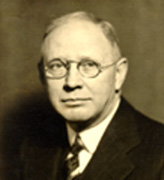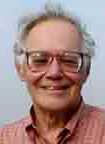The development of psychology in the late nineteenth and twentieth centuries has taken place in the offices of therapists, the laboratories of researchers, and the classrooms of teachers. An important part of psychology's emergence as a scientific discipline has been its growth as an academic specialty.
Psychology As An Academic Discipline
G. Stanley Ha ll
ll
G. Stanley Hall(1844-1924) was the first professor of psychology at an American university. While on the faculty at The Johns Hopkins University, Hall founded a psychological laboratory in 1883, and established the American Journal of Psychology, the first American professional journal in psychology, in 1887. In 1888 Hall moved on to become president of Clark University, where he emphasized graduate training, especially in psychology. In 1892 Hall founded the American Psychological Association, still the preeminent professional organization for psychologists.
Later in his career Hall turned to an interest in development and child psychology, producing the seminal works Adolescence in 1904 and Senescence in 1922.
Mary Whiton C alkins
alkins
Although the history of psychology seems disproportionately to be a chronicle of the endeavors of men, women were as present in the early development of scientific psychology as they have been in other disciplines. An important example is the work of Mary Whiton Calkins(1863-1930), who studied with Wundt in Leipzig and William James at Harvard and went on to a distinguished career on the faculty at Wellesley College. Although she had completed all requirements for her doctorate, Harvard refused to grant a Ph.D. to a woman. Because of this experience, she likewise refused Radcliffe's later offer to award her the doctorate.
Calkins became one of the early presidents of the American Psychological Association and authored two textbooks. Her work continued a lifelong interest in the interconncections between philosophy and psychology. Despite criticism from structuralists, she also maintained a particular focus on self-psychology, insisting that one's self is observed throughout introspective experience.
Modern Theory Development
Academic environments and the networks they comprise have always provided important avenues of communication amongt researchers and theorists. Researchers seldom work alone, and the very act of publishing one's findings or theories invites others' comments and contributions. Two important influences on modern psychology that have stimulated such exchange are neobehaviourism and cognitive psychology.
Neobehaviorism
Behaviourism in its most extreme form rejects the examination of any unobservable process. For example, one sequence of psychological experience can be summarized as follows:
S --> O --> R In this sequence, a stimulus (S) excites the sensory processes of an organism (O), which consequently makes a response (R).
In strict behaviourist terms, one might observe the S and the R, but not the processes occurring within the O. A behaviourist rejects as impossible and irrelevant questions such as "Did the O feel pain?" and "Did the O make the R deliberately?" Ultimately, since only the S and the R can be safely and objectively studied, the behaviourist approach is said to favour "S-R" ("stimulus-response") psychology.
Neobehaviourists("new behaviourists") introduced the concept of intervening variables, changes in processes within the organism which cannot be observed but can be used to explain S-R patterns.
One such ne obehaviourist was Clark L. Hull (1884-1952) (picture on the left) , whose 1943 work Principles of Behaviour listed a series of postulates or rules regarding the effects on behaviour of such intervening variables as derive and habit strength.
obehaviourist was Clark L. Hull (1884-1952) (picture on the left) , whose 1943 work Principles of Behaviour listed a series of postulates or rules regarding the effects on behaviour of such intervening variables as derive and habit strength.
Another neobehaviourist, Edward Chace Tolman(1884-1959), found it necessary to hypothesize that learning can take place even when it is not observable. Tolman allowed rats to explore mazes without offering them any rewards for being fast or accurate. The rats showed no signs of having learned the maze -- until a later time when they were rewarded for their maze running efforts. At that time the rats learned the maze faster than rats who had not explored the maze before. Obviously the experienced rats had learned something, although their learning had remained latent(hidden) until it was useful. Tolman developed the somewhat "mentalist" concept of latent learning while he conducted traditional behaviourist research on rats' performance times.
Cognitive Psychology
After World War II, problem-solving machinery and information technology combined to produce artificial intelligence, the software and hardware we take for granted as computers. Because to some extent computers stimulate many human-like cognitive processes (like thinking , remembering, and problem-solving), the study of artificial intelligence can yield some answers about the dynamics of human cognition.

Ulric Neisser (1928) has been influential in developing a model of human cognitive processes as actively involved in seeking information and meaning. Cognitive psychology -- the study of the psychological processes involved in cognitive functions -- combines time-honored Gestalt principles of perception with an interest in information processing, the sequence of cognitive operations whereby sensory experiences are meaningfully interpreted and acted upon.
Psychology As An Academic Discipline
G. Stanley Ha
 ll
llG. Stanley Hall(1844-1924) was the first professor of psychology at an American university. While on the faculty at The Johns Hopkins University, Hall founded a psychological laboratory in 1883, and established the American Journal of Psychology, the first American professional journal in psychology, in 1887. In 1888 Hall moved on to become president of Clark University, where he emphasized graduate training, especially in psychology. In 1892 Hall founded the American Psychological Association, still the preeminent professional organization for psychologists.
Later in his career Hall turned to an interest in development and child psychology, producing the seminal works Adolescence in 1904 and Senescence in 1922.
Mary Whiton C
 alkins
alkinsAlthough the history of psychology seems disproportionately to be a chronicle of the endeavors of men, women were as present in the early development of scientific psychology as they have been in other disciplines. An important example is the work of Mary Whiton Calkins(1863-1930), who studied with Wundt in Leipzig and William James at Harvard and went on to a distinguished career on the faculty at Wellesley College. Although she had completed all requirements for her doctorate, Harvard refused to grant a Ph.D. to a woman. Because of this experience, she likewise refused Radcliffe's later offer to award her the doctorate.
Calkins became one of the early presidents of the American Psychological Association and authored two textbooks. Her work continued a lifelong interest in the interconncections between philosophy and psychology. Despite criticism from structuralists, she also maintained a particular focus on self-psychology, insisting that one's self is observed throughout introspective experience.
Modern Theory Development
Academic environments and the networks they comprise have always provided important avenues of communication amongt researchers and theorists. Researchers seldom work alone, and the very act of publishing one's findings or theories invites others' comments and contributions. Two important influences on modern psychology that have stimulated such exchange are neobehaviourism and cognitive psychology.
Neobehaviorism
Behaviourism in its most extreme form rejects the examination of any unobservable process. For example, one sequence of psychological experience can be summarized as follows:
S --> O --> R In this sequence, a stimulus (S) excites the sensory processes of an organism (O), which consequently makes a response (R).
In strict behaviourist terms, one might observe the S and the R, but not the processes occurring within the O. A behaviourist rejects as impossible and irrelevant questions such as "Did the O feel pain?" and "Did the O make the R deliberately?" Ultimately, since only the S and the R can be safely and objectively studied, the behaviourist approach is said to favour "S-R" ("stimulus-response") psychology.
Neobehaviourists("new behaviourists") introduced the concept of intervening variables, changes in processes within the organism which cannot be observed but can be used to explain S-R patterns.
One such ne
 obehaviourist was Clark L. Hull (1884-1952) (picture on the left) , whose 1943 work Principles of Behaviour listed a series of postulates or rules regarding the effects on behaviour of such intervening variables as derive and habit strength.
obehaviourist was Clark L. Hull (1884-1952) (picture on the left) , whose 1943 work Principles of Behaviour listed a series of postulates or rules regarding the effects on behaviour of such intervening variables as derive and habit strength.Another neobehaviourist, Edward Chace Tolman(1884-1959), found it necessary to hypothesize that learning can take place even when it is not observable. Tolman allowed rats to explore mazes without offering them any rewards for being fast or accurate. The rats showed no signs of having learned the maze -- until a later time when they were rewarded for their maze running efforts. At that time the rats learned the maze faster than rats who had not explored the maze before. Obviously the experienced rats had learned something, although their learning had remained latent(hidden) until it was useful. Tolman developed the somewhat "mentalist" concept of latent learning while he conducted traditional behaviourist research on rats' performance times.
Cognitive Psychology
After World War II, problem-solving machinery and information technology combined to produce artificial intelligence, the software and hardware we take for granted as computers. Because to some extent computers stimulate many human-like cognitive processes (like thinking , remembering, and problem-solving), the study of artificial intelligence can yield some answers about the dynamics of human cognition.

Ulric Neisser (1928) has been influential in developing a model of human cognitive processes as actively involved in seeking information and meaning. Cognitive psychology -- the study of the psychological processes involved in cognitive functions -- combines time-honored Gestalt principles of perception with an interest in information processing, the sequence of cognitive operations whereby sensory experiences are meaningfully interpreted and acted upon.
No comments:
Post a Comment